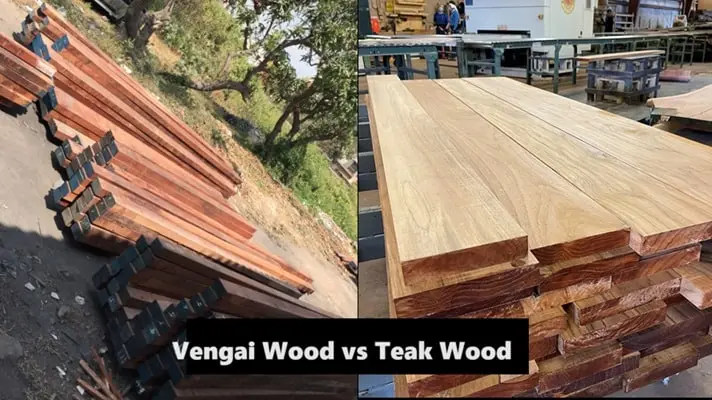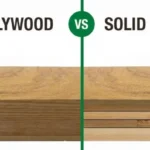Whether we talk about Vengai Wood or Teak Wood, both are known for their exceptional durability and they look pretty decent too. And if you are having a hard time deciding which type of wood to choose for your very next woodworking project, well, keep on reading today’s post. Why? Well, that’s simply because we are about to share the thorough lowdown on both Vengai and Teak wood, walking you through the pros and cons of both. So, by the end of this post, you’ll precisely know which option is probably the best for your project. Here we go.
Vengai Wood:
A dense hard wood with a yellow brownish colour having a gold fleck running through a grain is known as Vengai Wood.Vengai is also referred to as “Merbau”, “Kwila”, and in Karnataka as “Honne”. In Tamil Nadu, it is “God’s Tree”.
Pros:
– Appearance:
Vengai wood has a beautiful reddish-brown color from inside with a unique grain pattern looks similar to that of gold. It enhances the aesthetic appeal of furniture and interiors. It is also widely used in temple doors and chariots. The rich color deepens over years, adding extra beauty to each piece.
– Durability:
The wood is easy to work and also it is very stable. As there are lesser chances for bending and cracks, it can be used almost in any application such as door frames, window frames, door shutters & window shutters. Vengai wood has a high resistance to heat. It does not burnt easily while exposed to fire. So it is highly recommended to prefer for main doors.
– Sustainability:
Compared to many exceptional hardwoods, Vengai wood is incredibly sustainable. It is often sourced from controlled forests in India, making sure that logging practices are regulated and that reforestation efforts are in vicinity. This sustainability aspect makes Vengai wood an environmentally pleasant choice for those involved approximately deforestation and ecological effect.
– Pest free:
Vengai wooden is obviously immune to termites and other insects because of its excessive content of herbal oils. This makes renovation of vengai timber clean and removes the need for pest management.
Cons:
– Cost:
Vengai wooden comes at a excessive cost, resulting in a constrained variety of people choosing it. Its price tag surpasses that of teakwood by means of an extensive margin. Therefore, Vengai wood is typically chosen simplest even with price isn’t always a difficulty.
– Maintenance:
It is crucial to save Vengai wooden in a dry place to prevent any moisture-associated problems. Staining can occur if the wooden is exposed to moisture or water logging. Additionally, its miles really useful to influence clean of buying old stocks while acquiring Vengai timber.

Teak Wood:
Teak wooden is sourced from the teak tree, which grows certainly in Malaysia, Bangladesh, Indonesia, India, Myanmar, Sri Lanka, and Thailand. With time, the wood develops a darker tone and is appreciably grown in those areas, making it a preferred desire.
Pros:
– Durability:
Teak wood is familiar for its amazing durability and aesthetic visual appeal. Its grain patterns make a contribution to its popularity as one of the maximum attractive kinds of timber. The natural golden-brown color enhances its desirability, making it a favored option for furniture.
– Ease to work:
Teak timber is an exceptionally favored fabric among craftsmen due to its workability. Many artisans pick out to work with teak over other varieties of timber. Additionally, teak wooden can be polished effectively and demands minimal maintenance.
– Long term investment:
While teak is extra costly than many other varieties of wood, its miles considered an extended-term investment because of its toughness and requirements. Furniture and cabinets made from teak can used over generations, supplying price for money through the years. Its enduring appeal also method that teak gadgets regularly maintain or maybe increase their fee over years.
– Maintenance:
Teak wood is rather preferred for its waterproof properties, making it a brilliant desire for outdoor furnishings, decking, and construction tasks. Additionally, the herbal oils found in teak wood provide safety towards termites, decay, and numerous bugs, making sure that your fixtures have an extended lifespan. As a result, teak timber is regularly the preferred alternative for many families.
Cons:
– Expensive:
Teak ranks the various priciest hardwoods, making it a luxurious alternative for substantial initiatives or people with restricted budgets. Its density and weight can pose difficulties in transportation and dealing with, similarly growing the charges and details of initiatives that necessitate enormous amounts of wood.
– Environmental impact:
While teak wood is prized for its toughness and resistance to decay, its reputation has brought about overharvesting, which poses a serious threat to its sustainability. Natural teak forests, especially in Southeast Asia, were heavily depleted. Moreover, the environmental effect of changing large tracts of land into Teak plantations may be damaging, affecting biodiversity and neighborhood ecosystems. This raises ethical and environmental worries for consumers who prioritize sustainability.
– Source challenge:
One of the disadvantages of teak timber is that it’s far difficult to procure exquisite teak wood. Many suppliers promote teak-covered or teak-oiled timber to trick the customers.


